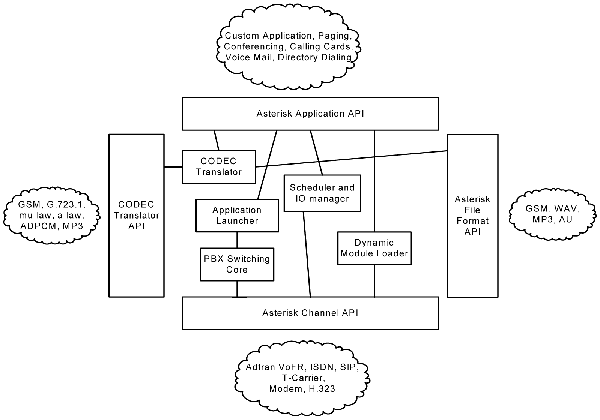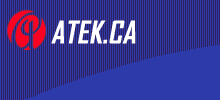|
1 - Technical Feature List
At the time of writing, provides the following features. New features are regularly added.
- Telephony Services
-
Voicemail System
- Password Protected
- Separate Away and Unavailable Messages
- Default or Custom Messages
- Multiple Mail Folders
- Web Interface for
Voicemail Checking
- E-mail notification of
Voicemail
-
Voicemail Forwarding
- Visual Message Waiting Indicator
- Message Waiting Stutter Dialtone
- Auto Attendant
- Interactive Voice Response
- Overhead Paging
- Flexible Extension Logic
- Multiple Line Extensions
- Multi-Layered Access Control
- Direct Inward System Access
- Directory Listing
- Conference Bridging
- Unlimited Conference Rooms
- Access Contro
- Call Queuing
- ADSI Menu System
- Support for Advanced Telephony Features
- PBX Driven Visual Menu Systems
- Visual Notification of
Voicemail
- Call Detail Records
- Local Call Agents
- Remote Call Agents
- Protocol Bridging
- Provides seamless integration of technologies
- Offers a unified set of services to users regardless of connection type
- Allows interoperability of VoIP systems
- Call Features
- Music on Hold
- Music on Transfer
- Flexible mp3 based system
- Volume Control
- Random Play
- Linear Play
- Call Waiting
- Caller ID
- Caller ID Blocking
- Caller ID on Call Waiting
- Call Forward on Busy
- Call Forward on No Answer
- Call Forward Variable
- Call Transfer
- Call Parking
- Call Retrieval
- Remote Call Pickup
- Do Not Disturb
- Scalability
- TDMoE
- Allows Direct Connection of PBX
- Offers Zero Latency
- Uses Commodity Ethernet Hardware
- Voice over IP
- Allows for Integration of Physically Separate Installations
- Uses commonly deployed data connections
- Allows a unified dial plan across multiple offices
- Voice over IP Interoperability
- Inter- Exchange (IAX)
- H.323
Session Initiation Protocol SIP)
- Media Gateway Control Protocol (MGCP)
- Traditional Telephony Interoperability
- Robbed Bit Signaling Types
- FXS and XO
- Loopstart
- Groundstart
- Kewlstart
- E&M
- E&M Wink
- Feature Group D
- PRI Protocols
4ES
- Lucent 5E
- DMS100
- National ISDN2
- EuroISDN
- BRI (ISDN4Linux)
- Codec Support
- GSM
- G.729 (available through purchase of commercial license(s))
- G.723.1 (pass through)
- Linear
G.711 Mu-La
- G.711 A-Law
- ADPCM
- ILBC
- LPC-10
- MP3 (decode only)
Getting Help
Commercial support for development and hardware is available from
training and support.
Please send any suggestions about improvements or corrections to www.atek.ca/contact
2 - Architecture
Internet and telephony technologies with Internet and telephony
applications. applications connect any phone, phone line or packet voice connection to an
other interface or service. easily and reliably scales from very small to very large systems
supports high density, redundant applications
The technologies include VoIP, SIP, H.323, IAX, and BGCP (for gateways and phone.) can interoperate with almost all standards-based telephony equipment. Hardware to connect your system is inexpensive.
supports traditional telephone technologies like ISDN PRI and T-Carrier including T1 and E-1.
Telephony applications include calling, conferencing, call bridging, voicemail, auto attendant, custo
Interactive Voice Response scripting, call parking, intercom, and many others.
A server connected to a local area network can control phones connected to that local area
network. These phones can call each other through the server. The server can contro
phones connected to other networks or the Internet, even if those phones or the server are
behind firewalls.
With FXS interface cards, an server can control local analog telephones. XO and T-carrier interface boards from can connect an server to the PSTN. This allows calls to
be made to and from the PSTN. PSTN users can call phones controlled by the server, phones can call users on the PSTN.
Calls can be switched from one server to another server. A telephone controlled by
an server can call a telephone controlled by a second server. A call from a telephon
controlled by one server can be switched to a second server and then on to th
PSTN.
As shown in figure one, contains engines that perform critical functions. When
starts, theDynamic Module Loader loads and initializes drivers. The drivers provide channel drivers, file
formats, call detail recording backends, codecs, and applications, among others.
The PBX Switching Core accepts telephone calls from the interfaces. The
Switching Core handles calls according to the instructions found in a dial plan. The
PBX Switching Core uses the Application Launcher to ring phones, to connect to voicemail, or to dial out on outbound trunks.
The PBX Switching Core includes a
Scheduler and I/O manager that is available to drivers and applictions. The Codec Translator seamlessly connects channels that compressed with different codecs. Most
of 's flexibility comes from the applications, codecs, channel drivers, file formats and othe
facilities interaction with the various programming interfaces.
 |
| Figure: 02-1 Major Subsystems |
Interfaces & Channels
You must understand what interfaces are available and how they work to be able to install or configure
. You will never be successful in configuring or maintaining unless you understan
interfaces and their interaction with
All calls arrive at or leave an server through an interface, for example SIP , Zaptel or IAX.
Any incoming or outgoing call is made through an interface.
Every call is placed or received over an interface on its own distinct channel. A channel can be connected to a physical channel like a POTS line, or to a logical channel like an IAX or SIP channel.
It is very important to differentiate the arrival of a call on a channel from what is done with that
incoming call. When a call arrives at over a channel, a dial plan determines what is done wit
the call. For example, a call might arrive through aSIP channel. The call could be coming from a SIP
telephone, or from aSIP soft phone running on a computer. The dial plan determines if the call
should be answered, connected to another telephone, forwarded or directed to voice mail.
provides various applications, for example voice mail. These applications are available to the
dial plan when processing the incoming call. The dial plan and the applications selected for use withi
the dial plan determine what Atersisk does.
Different types of interfaces are associated with different kinds of hardware or protocols. For example,
SIP channels are used to route calls in and out of an server over IP with Session Initiation
Protocol. A call can come in to an server through aSIP channel or leave the server
outbound to the Internet through a SIP channel.
All calls arrive on a channel. Even internal calls. For example, a legacy analog telephone can be directly
connected to an server with the appropriate interface board. When the user picks u
the handset, a channel is activated. The user's call then flows through the activated channel. The dia
plan determines what should happen to this call, for example dialing another internal number ove
another analog channel, or dialing an outside telephone number, or accessing voice mail.
uses a channel driver (typically named chan_xxx.so) to support each type of channel. An
channel is specified in this way
/
Technology is one of installed channel modules, i.e. SIP, IAX, IAX2, MGCP, or Modem. The format
of the Dialstring depends on the type of channel selected. The standard distribution includes the following interface types
SIP - Session Initiation Protocol IETF
IAX - Inter- Exchange protocol - v1 and v
MGCP - Media Gateway Control Protocol / Megaco IET
ZAP - Zapata channel
Modem - Modem channels (Incl ISDN)
Skinny - Skinny channels (Cisco phones)
Voice over Frame Relay - Adtran styl
console - OSS console client driver for sound cards /dev/ds
vbp - VoiceTronix Interface drive
local - Loopback into another contex
H.323 - H.323 IT
phone - Telephony channe
agent - ACD Agent channe
Outgoing channels, for example for the Dial application, use names with the same format. Later chapters describe how to configure various types of channels.
| 
